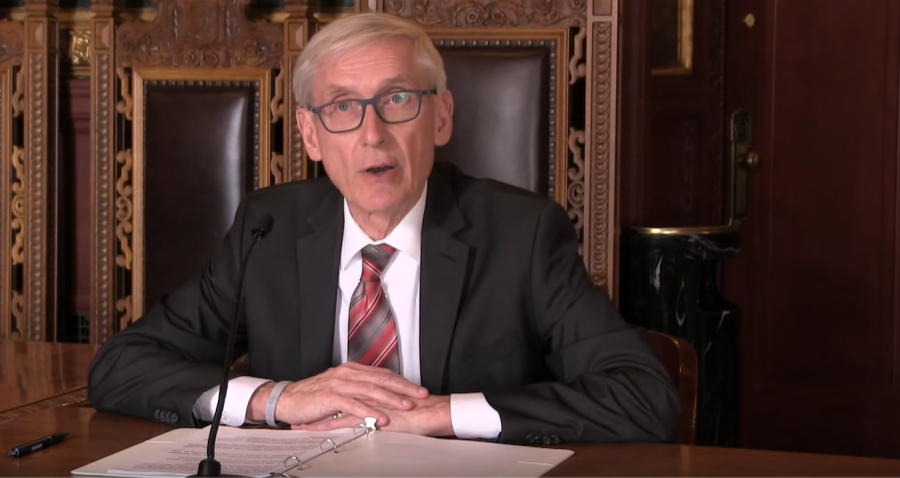Governor issues ‘Safer at Home’ order after COVID-19 cases skyrocket
Order prohibits nonessential travel from March 25-April 24
March 24, 2020
Today Gov. Tony Evers directed the Department of Health Services to issue a “Safer at Home” order prohibiting nonessential travel from March 25 to April 24 to prevent the Wisconsin’s healthcare system from being overwhelmed by thousands of coronavirus cases.
The order comes after confirmed cases of COVID-19 in Wisconsin have skyrocketed to 457 with five deaths resulting from the virus, according to DHS.
Under the order, residents are allowed to leave their homes for “essential activities,” such as seeing a doctor, going to the grocery store or pharmacy and caring for family members.
Individuals are allowed to go outdoors as long as they maintain social distance, 6 feet from any other person, unless the person is a member of their household. The order also bans public and private gatherings among people not part of a single household.
Businesses allowed to continue operation include, but are not limited to health care operations, critical infrastructure, those providing social services and necessities of life, food retailers, those shipping or delivering groceries directly to residences, pharmacies, health care facilities, child care facilities, gas stations and auto repair facilities, banks, laundry businesses, hardware stores, plumbers, electricians, educational institutions facilitating distance learning, law enforcement and other essential government functions.
In a media briefing Tuesday, Evers acknowledged that last week he didn’t think a safer at home order would be necessary, but after speaking with public health experts he thinks it’s the best decision possible.
“The bottom line is that COVID-19 continues to be a rapidly evolving situation, sometimes changing by the hour,” Evers said. “That means sometimes our responses have to change as we have more information.”
The decision to issue the order was necessary to ensure the health care system isn’t overwhelmed and to keep Wisconsinites safe, Evers said.
He urged residents to take the Safer at Home order seriously, and to limit their interactions to the members of their homes.
“Shrinking your circle of interactions will help prevent the spread of COVID-19 to make sure our health care system doesn’t become overwhelmed,” Evers said. “Unfortunately, that means no potlucks, no playdates and no dinner parties.”
Over the past several days, the governor’s office has been working with public health experts, local municipalities and business leaders to determine how to best keep the population safe, while continuing to provide essential services, Evers added.
At the briefing, DHS Secretary-Designee Andrea Palm said the decision to enact the Safer at Home order was not made lightly, but was necessary to “stem the tide of COVID-19.”
DHS is comparing data from Wisconsin to data from China and Italy to best predict what could happen in the state, she noted.
“If we continue on our current path, without implementing Safer at Home to flatten the curve, the models show us that we would likely have 22,000 Wisconsites who are positive for COVID-19 by April 8, and an estimated 440 to 1,500 deaths,” Palm said. “This means thousands of Wisconsinites would need hospitalization and we would exceed our current hospital bed capacity.”
Keeping the health care system from becoming overwhelmed is the state’s No. 1 priority, as there are currently no medications or vaccines to protect people from the disease, she said.
The only proven tool to prevent the spread is social distance, Palm added, before urging residents to stay at home.
Limiting contacts to less than five people total will help stop the spread, “not five people at a time, but five people total,” she said.
“We need you to be in physical contact with as few people as possible,” Palm said, adding that transmission can occur before symptoms develop, making it difficult to tell who’s infected.
As many as 20% of individuals who have tested positive for the virus in Wisconsin have required hospitalization, according to DHS Chief Medical Officer Ryan Westergaard.
DHS collects information about positive cases from reference labs, rather than hospitals themselves, so in many cases information about whether a patient is hospitalized is missing, Westergaard said.
DHS is trying to develop new strategies to look at data from multiple sources in order to better track health care system resources and understand who’s hospitalized at a given time, he added.
Because as many as 90% of individuals who have the virus don’t have symptoms that require medical care, Westergaard said that for every person that tests positive for COVID-19, there could be as many as 10 people in the community with mild symptoms.
“We have a small number of hundreds of cases in the state, but it could potentially be thousands right now,” he said.
Westergaard added that measures being taken to limit physical contact between people are the main tool for preventing cases from continuing to develop exponentially.
By continuing social distancing, “we can save many, many lives,” he said.














